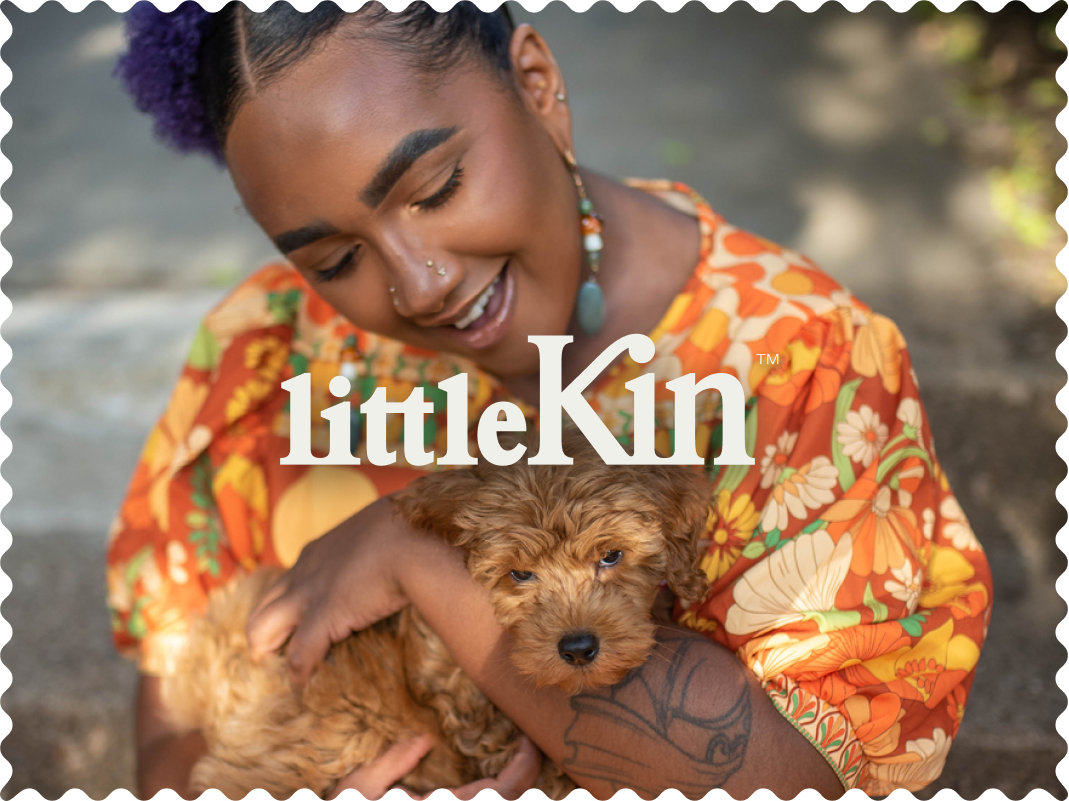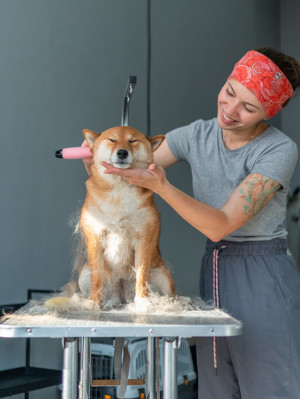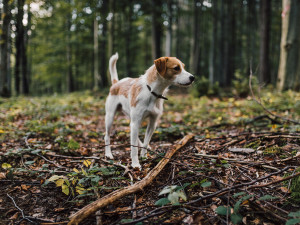Why Do Dogs Have Whiskers?
Other than using them to tickle you, of course.

Share Article
In This Article:
What Are Dog Whiskers? Why Do Dogs Have Whiskers? Where Are Whiskers Located on Dogs? Can You Cut a Dog’s Whiskers? Do Whiskers Grow Back? Caring for Your Dog’s Whiskers Frequently Asked Questions
A dog’s whiskers can add a lot of personality to their face. These stiff hairs will perk up during times of excitement and lay flat to show fear. But do dogs really use their whiskers? Can you cut a dog's whiskers off without causing problems?
Dog whiskers are important sensory tools and do much more than convey emotions, so they should never be cut without good cause.

What are dog whiskers?
Whiskers are actually hairs called “sinus hairs” or “vibrissae.” These hairs are set deep within specialized, blood-filled follicles rich in nerve endings. There are technically two types of whiskers, though most people only notice one. Macrovibrissae are the long, thick hairs found on a dog’s muzzle, chin, face, and eyebrows. Microvibrissae are much smaller hairs located just above the upper lip.
Many mammals have follicle-sinus complexes that grow whiskers and collect sensory information. The hair follicle for each dog whisker has a small muscle attached to it that allows for fine movement of the hair shaft. Being able to make miniscule adjustments to whisker position enhances their use as part of their sensory system. Humans (even those with long beards or eyebrows) don’t have an equivalent sensory tool, so it can be difficult for us to understand why they’re so important to dogs.
Why do dogs have whiskers?
A dog’s whiskers serve a few different roles in helping them interact with the world around them. Like many animals, dogs seem to use “face touch” to explore the world around them. There’s more happening than we realize when a dog extends their neck to give something a closer examination.
Sensory enhancement
Without realizing it, you’ve likely seen your dog using their whiskers to touch objects they’re interested in. Dogs use the small whiskers on their upper lip to gather sensory information about the shape and texture of objects, especially those they’re thinking about eating. This doesn’t mean they always make great decisions about what to eat (ask the many Labradors I’ve had to remove socks from), but they at least check things out first.
The long whiskers of the face help shape a dog’s picture of their current environment. These whiskers respond to pressure, displacement, and tension. Facial whiskers give dogs info about wind, how close an object is, and general indicators about the object's surface characteristics. Subtle changes in air currents may alert them to threats in the area.
Protection for sensitive areas
Some whiskers function in protecting delicate areas of a dog’s face. Dogs will reflexively blink their eyes when the whiskers on the muzzle or above the eyes are touched. This reflex serves to protect the eyes when the whiskers feel something that could cause injury.
Spatial perception
There are reports of vision-impaired dogs who suddenly had trouble navigating familiar spaces after their whiskers were cut. Dogs use their whiskers to help them avoid obstacles and to give them additional confidence about moving quickly through spaces. They can also use their whiskers to determine the size of an opening and decide if their body will fit through. If you’ve ever wondered, “Why do dogs have whiskers on their cheeks?” — it’s likely because of this. If their whiskers touch the edges, they’ll know that it’ll be a tight squeeze.
Emotional indicators
Dogs have many silent ways of communicating their emotions to people and other dogs. Whiskers that are flattened against the face likely indicate fear and an attempt to not appear as a threat. Flared whiskers indicate a more interested, alert, or aggressive posture. These subtle signals are one of dogs’ ways of telling the world how they’re feeling.
Where are whiskers located on dogs?
Dogs have organized sets of whiskers that appear in consistent locations. Depending on your dog’s hair coat, some of these may not be obvious until you go searching for them. A dog’s whiskers are found in the following locations:
Above the eyes: Known as the superciliary or supraorbital vibrissae, these whiskers are found above the eyelids, toward the middle of the face. In addition to their normal sensory functions, they help to protect the eyes. These whiskers may not be super obvious if your dog has bushy eyebrows and a dark coat color.
On the muzzle: These are the largest and most obvious whiskers for most dogs. Known as the mystacial (a fancy word for “moustache-y”) vibrissae, this large set of whiskers help determine distances and detect objects close to the face. They also cause a dog to blink and flinch if they sense something moving quickly toward them.
On the chin: Dogs have sets of whiskers along the skin beneath their jawline. These vibrissae assist with finding objects on the ground and general spatial awareness.
On the cheeks: There are two clusters of whiskers on either side of a dog’s face. They’re spaced evenly between the edge of the mouth and the ear. These whiskers may help with detecting the size of openings and determining if it’s safe to move through.
Above the lip: These microvibrissae used for delicate touch don’t stand out, but they’re important in helping dogs form a more detailed picture about objects they’ve encountered.
Can you cut a dog’s whiskers?
Many dogs have had their whiskers cut for various reasons over the years. Some breed standards even demanded trimmed whiskers in show dogs. Although cutting a dog’s whiskers doesn’t result in any visible harm in most cases, you shouldn’t cut them without a good reason. Some dogs may need their whiskers cut for surgical procedures or if they’re growing in a way that causes problems.
Cutting a dog’s whiskers removes a valuable sensory organ. Because dogs use their vibrissae to help them navigate the world, trimming their whiskers requires a reason more important than a preferred cosmetic appearance. Trimming a dog’s whiskers will compromise their ability to protect themselves from threats, find their way around obstacles, and interact with their surroundings.
Trimming whiskers does not improve a dog's appearance or health. Although the benefits of maintaining a full set of whiskers are plentiful, it’s still fairly common for them to be cut or shaved during grooming. If you have a dog who needs regular trims to look their best, be sure to discuss with your groomer that you want your dog’s whiskers to stay their normal length.
Do whiskers grow back?
If your dog has had their whiskers trimmed for any reason, don’t fear: dog whiskers do grow back. Whisker growth is slow, and it can take months for a whisker to return to its full length. Whiskers are lost naturally as part of a dog’s normal shedding cycle and begin to regrow during the start of the next cycle. This means you don’t have to worry if you come across a thick whisker on the ground when you’re cleaning.
Caring for your dog’s whiskers
If you groom your dog at home, you may not have considered how to maintain your dog’s whiskers as you’re helping them look their best. Whiskers are self-maintaining, so you shouldn’t have to do much to care for them beyond keeping an eye out for them when it’s time to get cleaned up. Some grooming tips for whiskers include:
Trim hair carefully: It’s easy to make mistakes when the whiskers are involved. Locate them before you start clipping or cutting hair and keep hair in the areas around them bushier to reduce the risk of accidentally trimming a whisker.
Avoid accidental cutting: Dogs aren’t always patient when it comes to styling their hair, and they can be very sensitive when their whiskers are involved. As much as possible, try to avoid contacting their whiskers as you’re trimming around the face. Because whiskers help keep dogs safe from threats, they may flinch or move suddenly when the whiskers are touched. This can result in some grooming “oopsies” that are no fun for the dog or groomer.
Be gentle around whiskers: Even if your dog doesn’t require trimming, it’s still good to be mindful of their whiskers during bathing. Don’t tug on whiskers or scrub vigorously around them. They’re sensitive to very slight touch, so it doesn’t take much to overstimulate them.
Bottom line
Because dogs use their whiskers in ways we can’t entirely understand, it’s important to maintain them in their natural state as much as possible. Although it has been common for certain dog breeds to maintain a more sleek appearance by having their whiskers shaved, this practice is unnecessary and removes an important sensory organ for dogs. Don’t trim your dog’s whiskers, and let your dog’s groomer know that you’d like them to leave the whiskers where they are.
FAQs
Why do dogs and cats have whiskers?
Dogs and cats have whiskers to assist their sense of touch and communicate with other animals. They use whiskers to explore nearby objects, detect threats, and assist with their spatial awareness.
Can cutting whiskers cause pain in dogs?
Because whiskers are hair, they do not have pain sensors within them. Whiskers are anchored in very sensitive follicles though, so the tugging and manipulation during cutting may be painful.
How can I tell if my dog’s whiskers are healthy?
Whisker appearance (length, thickness, and straightness) will vary some by breed. For most dog breeds, whiskers should be longer than the surrounding hairs, slightly curved, and a little firm.
References
Döring, Dorothea et al. “Bedeutung der Tasthaare beim Haushund und Problematik des Abschneidens aus Sicht des Tierschutzes” [The importance of the tactile hairs in domestic dogs and the problem of trimming these from an animal welfare perspective]. Tierarztliche Praxis. Ausgabe K, Kleintiere/Heimtiere vol. 48,3 (2020): 186-195. doi:10.1055/a-1162-1370opens in new tab.
Döring, Dorothea et al. “The canine vibrissal system as a highly innervated and functional sensory organ.” Scientific Reports vol. 15,1 9212. 17 Mar. 2025, doi:10.1038/s41598-025-91629-1opens in new tab.
Grant, R.A. et al. “What can whiskers tell us about mammalian evolution, behaviour, and ecology?” Mammal Review 52: 148-163 (2021). doi:10.1111/mam.12253opens in new tab.
Lenkei, R et al. “That dog won't fit: body size awareness in dogs.” Animal Cognition vol. 23,2 (2020): 337-350. doi:10.1007/s10071-019-01337-3opens in new tab.
Muchlinski, Magdalena N et al. “Comparative histomorphology of intrinsic vibrissa musculature among primates: implications for the evolution of sensory ecology and "face touch".” American journal of physical anthropology vol. 150,2 (2013): 301-12. doi:10.1002/ajpa.22206opens in new tab.

Dr. Bartley Harrison, DVM
Dr. Bartley Harrison is a veterinarian with more than 19 years of experience. He has treated a variety of species in emergency and speciality practices for both large and small animals. His primary interests as a vet are emergency medicine and critical care.
Related articles
![Unrecognizable man sitting at desk petting his dog]()
How to Pet a Dog — Yes, You Do Need Lessons
There’s a difference between being affectionate and being annoying.
![The-Wildest_Editorial_Puppy-grooming-tips_Hero_1000x750_v01.jpg]()
How to Groom Your New Puppy
Celebrity dog groomer Jess Rona’s puppy grooming pro tips.
How Often Should You Groom Your Dog?
Just make sure you spell out “B-A-T-H.”
![greyhound dog being washed in tub]()
Lather, Rinse, Repeat: The Ultimate Dog Grooming Guide
Keep your dog well-groomed but trust trims to the pros.
Dog Senses: What Are Dogs’ Strongest Senses?
That little nose sure works well...
![Dog standing in woods sensing magnetic field]()
Dogs Have an Internal Compass
Your dog’s sense of direction changes with the Earth’s magnetic fields, influencing their orientation when pooping and acting as an internal compass.








